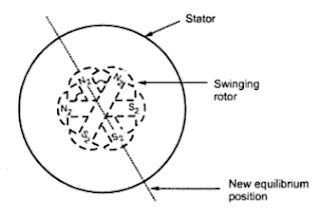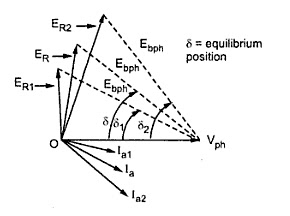With the extensive use of synchronous machines, the importance
of thoroughly investigating the influence of electrical
constants such as resistance and reactance, on hunting is obvious. Hunting is a term used to designate the oscillations of
the rotating parts of machines when they are accelerated or decelerated
with respect to normal speed. It is essentially a mechanical
phenomenon and produces pulsations in the current, voltage
and power, due to the variations of angular velocity (due to irregularity
of torque) or to the electrical operation of the machines;
and if the oscillations exceed a certain amount the regulation
of the machines becomes unstable and they fall out of step.
When a synchronous motor is loaded to a varying load, the rotor of the motor falls back by certain angle behind the revolving magnetic field. As the load on the motor is progressively increased, this angle also increases so as to produce necessary torque required to cope up with the load. If the load is suddenly decreased, the motor is immediately pulled up or advanced to a new value corresponding to new load. But in this process the rotor overshoot, hence it is again pulled back. In this way the rotor starts oscillating about its new position of equilibrium corresponding to a new load. If the time period of this oscillation happens to be equal to natural time period of the machine, the mechanical resonance is set up.
When a synchronous motor is loaded to a varying load, the rotor of the motor falls back by certain angle behind the revolving magnetic field. As the load on the motor is progressively increased, this angle also increases so as to produce necessary torque required to cope up with the load. If the load is suddenly decreased, the motor is immediately pulled up or advanced to a new value corresponding to new load. But in this process the rotor overshoot, hence it is again pulled back. In this way the rotor starts oscillating about its new position of equilibrium corresponding to a new load. If the time period of this oscillation happens to be equal to natural time period of the machine, the mechanical resonance is set up.
The amplitude of these oscillations is built up to a very large value and may eventually become so great that machine is thrown out of the synchronism. This oscillations of rotor about its equilibrium position due to change in load is called hunting. To stop the build up of these oscillations, damper winding are employed which consist of short copper bars embedded in the faces of field pole of the motor. The oscillations of rotor sets up eddy current in the damper winding which flow in such a way so as to suppress the oscillations.
Figure above shows the variation in current during hunting.





0 comments: